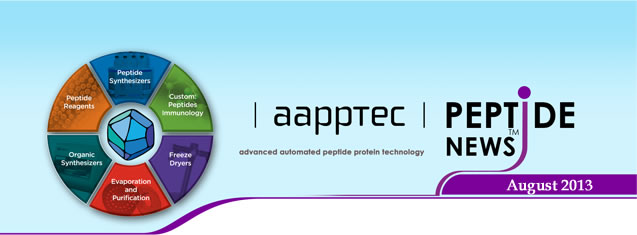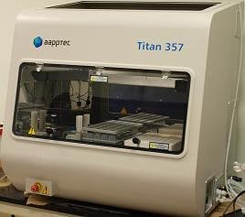|
 |
|
Oligonucleotide and Peptide Based Therapeutics Congress Global Engage is pleased to announce, as part of both their Genomic and Biologic series of events, the Oligonucleotide & Peptide Based Therapeutics Congress, which will be held on November 18-19 in San Diego, CA, USA.
For more information about the Oligonucleotide and Peptide Based Therapeutics Congress, please go to http://www.globalengage.co.uk/peptidetherapeutics.html. |
|
Featured Articles Evaluation of a D-amino Acid Containing FRET-Peptide Library for Profiling Prokaryotic Proteases. W. E. Kaman, I. Voskamp-Visser, D. M. de Jongh, H. P. Endtz, A. van Belkum, J. P. Hays, F. J. Bikker, Anal Biochem. 2013 Jul 10 DOI: 10.1016/j.ab.2013.06.015. [Epub ahead of print] Bacterial proteases play an important role in a broad spectrum of processes, including colonization, proliferation and virulence. In this respect, bacterial proteases are potential biomarkers for bacterial diagnosis and targets for novel therapeutic protease inhibitors. To investigate these potential functions, the authors designed and utilized a protease substrate Fluorescence Resonance Energy Transfer (FRET)-library comprising 115 short D- and L-amino acid containing fluorogenic substrates as a tool to generate proteolytic profiles for a wide range of bacteria. Bacterial specificity of the D-amino acid substrates was confirmed using enzymes isolated from both eukaryotic and prokaryotic organisms. Interestingly, bacterial proteases which are known to be involved in housekeeping and nutrition, but not in virulence, were able to degrade substrates in which a D-amino acid was present. Using our FRET- peptide library and culture supernatants from a total of 60 different bacterial species revealed novel, bacteria-specific, proteolytic profiles. Though in-species variation was observed for Pseudomonas aeruginosa, Porphyromonas gingivalis and Staphylococcus aureus. Overall the specific characteristic of our substrate peptide library makes it a rapid tool to high-throughput screen for novel substrates to detect bacterial proteolytic activity. Copyright © 2013. Published by Elsevier Inc. High throughput screening of one-bead-one-compound peptide libraries using intact cells C.-F. Cho, B. B. Azad, L .G. Luyt, J. Lewis ACS Comb. Sci., Just Accepted Manuscript DOI: 10.1021/co4000584 Publication Date (Web): July 2, 2013 Copyright © 2013 American Chemical Society Screening approaches based on one-bead-one-compound (OBOC) combinatorial libraries have facilitated the discovery of novel peptide ligands for cellular targeting in cancer and other diseases. Recognition of cell surface proteins is optimally achieved using live cells, yet screening intact cell populations is time-consuming and inefficient. Here, we evaluate the COPAS large particle biosorter for high throughput sorting of bead-bound human cell populations. When a library of RGD-containing peptides was screened against human cancer cells that express avß3 integrin, it was found that bead-associated cells are rapidly dissociated when sorted through the COPAS instrument. When the bound cells were reversibly cross-linked onto the beads, however, we demonstrate that cell-bead mixtures can be sorted quickly and accurately. This reversible cross-linking approach is compatible with MALDI-TOF/TOF mass spectrometry-based peptide sequence deconvolution. This approach should allow one to rapidly screen an OBOC library and identify novel peptide ligands against cell surface targets in their native conformation. Profiling the Substrate Specificity of Protein Kinases by On-Bead Screening of Peptide Libraries T. B. Trinh, Q. Xiao, D. Pei, Biochemistry, Just Accepted Manuscript DOI: 10.1021/bi4008947 Publication Date (Web): July 15, 2013 Copyright © 2013 American Chemical Society A robust, high-throughput method has been developed to screen one-bead-one-compound peptide libraries to systematically profile the sequence specificity of protein kinases. Its ability to provide individual sequences of the preferred substrates permits the identification of sequence contextual effects and non-permissive residues. Application of the library method to kinases Pim1, MKK6, and Csk revealed that Pim1 and Csk are highly active toward peptide substrates and recognize specific sequence motifs, whereas MKK6 has little activity or sequence selectivity against peptide substrates. Pim1 recognizes peptide substrates of the consensus RXR(H/R)X(S/T); it accepts essentially any amino acid at the S/T-2 and S/T+1 positions, but strongly disfavors acidic residues (Asp or Glu) at the S/T-2 position and a proline residue at the S/T+1 position. The selected Csk substrates show strong sequence covariance and fall into two classes with the consensus sequences of (D/E)EPIYX and (D/E)(E/D)S(E/D/I)YX (where X is any amino acid and is a hydrophobic amino acid). Database searches and in vitro kinase assays identified phosphatase PTP-PEST as a Pim1 substrate and phosphatase SHP-1 as a potential Csk substrate. Our results demonstrate that the sequence specificity of protein kinases is defined not only by favorable interactions between permissive residue(s) on the substrate and their cognate binding site(s) on the kinase, but also by repulsive interactions between the kinase and non-permissive residue(s). Urocortin protects chondrocytes from NO-induced apoptosis: a future therapy for osteoarthritis? N. Y. Intekhab-Alam, O. B. White, S. J. Getting, A. Petsa, R. A. Knight, H. S. Chowdrey, P. A. Townsend, K. M. Lawrence, I. C. Locke, Cell Death Dis. 2013, 4, e717. DOI: 10.1038/cddis.2013.231. Osteoarthritis (OA) is characterized by a loss of joint mobility and pain resulting from progressive destruction and loss of articular cartilage secondary to chondrocyte death and/ or senescence. Certain stimuli including nitric oxide (NO) and the pro-inflammatory cytokine tumor necrosis factor a (TNF-a) have been implicated in this chondrocyte death and the subsequent accelerated damage to cartilage. In this study, we demonstrate that a corticotrophin releasing factor (CRF) family peptide, urocortin (Ucn), is produced by a human chondrocyte cell line, C-20/A4, and acts both as an endogenous survival signal and as a cytoprotective agent reducing the induction of apoptosis by NO but not TNF-a when added exogenously. Furthermore, treatment with the NO donor S-nitroso-N-acetyl-D-L-penicillamine upregulates chondrocyte Ucn expression, whereas treatment with TNF-a does not. The chondroprotective effects of Ucn are abolished by both specific ligand depletion (with an anti-Ucn antibody) and by CRF receptor blockade with the pan-CRFR antagonist a-helical CRH(9-41). CRFR expression was confirmed by reverse transcription-PCR with subsequent amplicon sequence analysis and demonstrates that C-20/A4 cells express both CRFR1 and CRFR2, specifically CRFR1a and CRFR2ß. Protein expression of these receptors was confirmed by western blotting. The presence of both Ucn and its receptors in these cells, coupled with the induction of Ucn by NO, suggests the existence of an endogenous autocrine/paracrine chondroprotective mechanism against stimuli inducing chondrocyte apoptosis via the intrinsic/mitochondrial pathway. Enantiomeric and diastereoisomeric (mixed) I/d-octaarginine derivatives - a simple way of modulating the properties of cell-penetrating peptides. N. Purkayastha, K. Eyer, T. Robinson, P. S. Dittrich, A. K. Beck, D. Seebach, B. Kolesinska, R. Cadalbert, Chem Biodivers. 2013, 10, 1165-84. DOI: 10.1002/cbdv.201300180. Cell-penetrating peptides (CPPs) are promising vehicles for delivery of drugs, antibiotics, proteins, nucleic acid derivatives, etc. into eukaryotic and prokaryotic target cells. To prevent premature degradation, CPPs consisting of D- or ß-amino acid residues have been used. We present simple models for the various modes of delivery of physiologically active cargoes by CPPs, depending on the nature of their conjugation (Fig. 1), and we describe the plasma stability of oligoarginines (OAs) 1-4, the most common unnatural CPPs. Fluorescein-labeled L-octaarginine 1 was found to have a half-life (t1/2 ) of <0.5 min, the D-enantiomer (2) of >7 d (Fig. 2). For possible medicinal applications, the former type of derivative would be too unstable, and the latter one undesirably persistent. Thus, seven of the 256 possible 'mixed' Flua-L/D-octaarginine amides, 4a-4g, were synthesized and shown to have half-lives in heparine-stabilized human plasma between 8 min and 5.5 h (Figs. 3 and 4). The cell penetration of the new OAs was investigated with 'healthy' and with apoptotic HEK cells (Figs. 5-8), and their interactions with phospholipid bilayers were studied, using anionic lipid vesicles (Figs. 9 and 10). There are surprisingly large differences in the rates of cell penetration and binding to vesicle walls between the various stereoisomeric octaarginine derivatives 1, 2, and 4a-4g (Figs. 5 and 7). - The role of D-amino acids and D-peptides in nature and in drug design is briefly discussed and referenced. Copyright © 2013 Verlag Helvetica Chimica Acta AG, Zürich. Thymosin β4 Attenuates Early Diabetic Nephropathy in a Mouse Model of Type 2 Diabetes Mellitus. J. Zhu, L. P. Su, Y. Zhou, L. Ye, K. O. Lee, J. H. Ma, Am J Ther. 2013, Jul 10. [Epub ahead of print] The chronic inflammatory processes and endothelial dysfunction play important roles in the development of diabetic nephropathy (DN); the study aims to evaluate the effect of thymosin β4 (Tβ4), which has apparent anti-inflammatory properties and is capable of improving endothelial dysfunction, in early DN in a mouse model of type 2 diabetes mellitus. KK Cg-Ay/J (KK) mice, aged 12-14 weeks, were divided into the following groups: KK control group that was treated with saline; KK Tβ4 group that was treated with Tβ4 100 ng/10 g of intraperitoneal injection once a day. Nondiabetic age-matched C57BL mice were used as additional normal control and also treated with Tβ4. The urinary albumin/creatinine ratio (ACR), plasma urea nitrogen and creatinine, body weight, fasting blood glucose and 2-hour blood glucose during oral glucose tolerance testing, blood hemoglobin A1c, cholesterol, and triglyceride were determined at baseline time and 12 weeks after Tβ4 treatment for phenotypic characterizations. The KK Tβ4 group had reduced the mean fasting blood glucose, 2-hour blood glucose during oral glucose tolerance testing, hemoglobin A1c, and triglyceride levels compared with that in the KK control group (P < 0.05). Tβ4 treatment markedly reduced ACR (KK Tβ4 = 328.54 ± 46.14 mg/g vs. KK control = 540.34 ± 50.31 mg/g, P < 0.05). Tβ4 also significantly ameliorated renal pathological changes of KK Tβ4 mice as compared with that in KK control mice. Tβ4 treatment did not affect glucose homeostasis and urinary ACR and glomeruli of C57BL mice. These data in a novel mouse model of DN suggest that Tβ4 may ameliorate renal damage. This peptide may be a novel potential alternative agent for treatment of DN. |
|
Summer Savings Order any Fmoc-L-amino acid or Rink Amide Resin online at www.aapptec.com by September 30 and save 15% off the regular catalog price. Enter the coupon code Summer25 for these special savings.
Sale on Fmoc-D-Amino Acids Order Fmoc-D-amino acids by September 30 and pay these special, reduced prices.
Order AAPPTec Products online at www.aapptec.com, and Save Time! Titan 357 Combinatorial Library Synthesizer
The Titan 357 Combinatorial Peptide Library Synthesizer is the most efficient and easiest-to-use instrument for preparing one-bead-one-compound combinatorial libraries. Combinatorial
peptide libraries provide the means for preparing and screening very large numbers of peptides.
Urocortin Urocortin was recently reported to protect chondrocytes from NO-induced apoptosis (NY Intekhab-Alam, et al., Cell Death Dis. 2013, 4, e717). As osteoarthritis is characterized by the pain and loss of joint mobility resulting from the damage and loss of cartilage accelerated by chondrocyte death, urocortin may provide leads to future therapies for osteoarthritis. AAPPTec provides high purity urocortins for research applications.
Oligoarginines are cell penetrating peptides with great potential for delivering antibiotics, drugs, proteins and nucleic acid derivatives into targeted cells. Recently, PS Dittrich, D Seebach, B Kolesinska and coworkers studied the plasma half-lives of enatiomeric and diasteriomeric octaarginie derivates. L-octaarginine has a half-life of less than 30 seconds which is too short for practical pharmaceutical applications. D-octaarginine, on the other hand, had a half-life of over 7 days. For medical applications, this is too long. Some diasteriomeric octaarginines containing D- and L-arginine residues had half-lives in a more useful range of 8 minutes to 5.5 hours. However, there were large differences in the rates of cell penetration.
Thymosin β4 plays a role in tissue regeneration. It was recently reported to attenuate early diabetic nephropathy in a mouse model of Type 2 diabetes mellitus (J. Zhu, et al., Am J Ther. 2013, Jul 10. [Epub ahead of print]). In mice, thymosin β4 has been shown to stimulate formation of new heart muscle cells from inactive precursor cells in the outer lining of adult hearts (N. Smart, et al., Nature, 2011, 474, 7353), to induce migration of these cells into heart muscle (N. Smart, P.R. Riley, Curr Protoc Stem Cell Biol., 2009 Chapter 2: Unit2C.2), and recruit new blood vessels within the muscle (N. Smart, P.R. Riley, Biochem. Soc. Trans., 2009, 37, 1018).
|
 |
UPCOMING EVENTS |
|
|
August 2013 15th International Congress of Immunology August 22-27 Milan, Italy September 2013 22nd Polish Peptide Symposium September 1-5 Peptide Arrays 2013 September 3-4 |
 |
